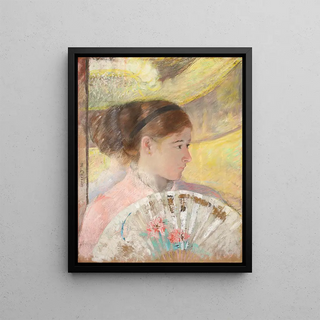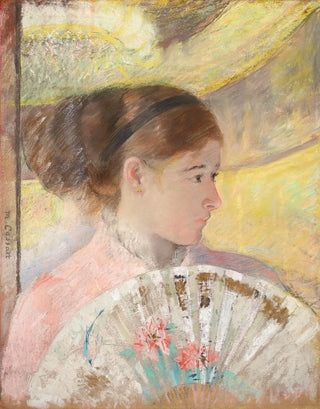Art print | Young woman in a box looking to the right - Mary Cassatt


View from behind

Frame (optional)
The artwork "Young Woman in a Loge Looking to the Right" by Mary Cassatt is an iconic piece that embodies the very essence of Impressionism. Created at the end of the 19th century, this painting invites viewers to immerse themselves in the intimacy of a fleeting moment, capturing the beauty and delicacy of a woman lost in her thoughts. The scene evokes not only a moment of contemplation but also the social and cultural dynamics of her time, when women began to claim their place in society. Through this work, Cassatt offers a unique perspective on the female world, while showcasing her undeniable talent.
Style and uniqueness of the work
Mary Cassatt's style is distinguished by her bold use of color and light. In "Young Woman in a Loge Looking to the Right," delicate shades of pink, blue, and green blend harmoniously, creating a soft and dreamy atmosphere. The composition is carefully thought out: the woman, positioned on the right, immediately draws the eye, while the elements of the loge, though present, do not steal the spotlight. Cassatt excels in depicting subtle emotions, and here, the slight smile of the young woman and her contemplative gaze suggest a psychological depth that invites reflection. The Impressionist technique, characterized by visible brushstrokes and a freer approach to form, gives this artwork a vitality and modernity that continue to captivate art enthusiasts.
The artist and her influence
Mary Cassatt, a major figure of Impressionism, managed to establish herself in an art world dominated by men. Born in 1844 in Pittsburgh, she spent much of her life in Paris, where she mingled with artists such as Degas and Monet. Cassatt was always deeply committed to representing women and their daily lives, challenging the conventions of her time. Her work goes beyond simple representation; she explores relationships, emotions, and the female condition. By incorporating elements of everyday life into her paintings, she paved the way for a new way of perceiving the world.

Matte finish

View from behind

Frame (optional)
The artwork "Young Woman in a Loge Looking to the Right" by Mary Cassatt is an iconic piece that embodies the very essence of Impressionism. Created at the end of the 19th century, this painting invites viewers to immerse themselves in the intimacy of a fleeting moment, capturing the beauty and delicacy of a woman lost in her thoughts. The scene evokes not only a moment of contemplation but also the social and cultural dynamics of her time, when women began to claim their place in society. Through this work, Cassatt offers a unique perspective on the female world, while showcasing her undeniable talent.
Style and uniqueness of the work
Mary Cassatt's style is distinguished by her bold use of color and light. In "Young Woman in a Loge Looking to the Right," delicate shades of pink, blue, and green blend harmoniously, creating a soft and dreamy atmosphere. The composition is carefully thought out: the woman, positioned on the right, immediately draws the eye, while the elements of the loge, though present, do not steal the spotlight. Cassatt excels in depicting subtle emotions, and here, the slight smile of the young woman and her contemplative gaze suggest a psychological depth that invites reflection. The Impressionist technique, characterized by visible brushstrokes and a freer approach to form, gives this artwork a vitality and modernity that continue to captivate art enthusiasts.
The artist and her influence
Mary Cassatt, a major figure of Impressionism, managed to establish herself in an art world dominated by men. Born in 1844 in Pittsburgh, she spent much of her life in Paris, where she mingled with artists such as Degas and Monet. Cassatt was always deeply committed to representing women and their daily lives, challenging the conventions of her time. Her work goes beyond simple representation; she explores relationships, emotions, and the female condition. By incorporating elements of everyday life into her paintings, she paved the way for a new way of perceiving the world.






